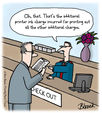Getting Help
- Mo Lidsky
- Apr 25, 2017
- 3 min read

...excerpt from Mo Lidsky's latest book, Partners in Preservation
Financial education may sound simple, and you may take it as a given that financial literacy is helpful in supporting better investment decisions. And it is. But the story is a bit more nuanced. Research seems to indicate that financial education has negligible—if any—impact on investors. In a survey of 168 papers, covering 201 studies, even large educational interventions proved to have limited effect over time (D. Fernandes, J. G. Lynch, and R. G. Netemeyer, “Financial Literacy, Financial Education and Downstream Financial Behaviors,” Management Science). What has proven to be effective, however, is when investment education is provided just in time, at the very moment where one is in the position to make investment decisions.
Regrettably, there is no Consumer Reports of investments and no easy shortcuts. To invest successfully, investors needs to find the resources that will help them make better investment decisions. This is difficult, as investors fall in love with investment ideas or become enamored by charismatic individuals. These positive emotions lead to negative outcomes. Donald G. MacGregor has shown that when an investment opportunity has a strong affective impact on us, we tend to overweigh the outcome rather than the probabilities of success (P. Slovic, M. L. Finucane, E. Peters, and D. G. MacGregor, “The Affect Heuristic,” European Journal of Operational Research). For example, when one imagines the prospect of winning the lottery, there is strong associative sentiments with the idea of newfound wealth and how a new, wealthy life might look. As a result, how many lottery tickets are bought will hardly be impacted by whether the chances of winning are one in five million or one in fifty million (even though winning the latter is ten times less likely). Similarly, when investors feel good about an investment, they tend to perceive the risks as being lower and the prospect of returns as being higher despite probabilities to the contrary (D. G. MacGregor, “Imagery and Financial Judgement,” Journal of Psychology and Financial Markets).
There may, however, be times when our guts, instincts, or emotions have something to add to our investing. Researchers have demonstrated our subconscious can often pick up on trends—positive or negative—even before our psyche does. In a well-known study, Antonio Damasio, a neuroscientist at the University of Southern California and an expert in somatic indicators, put several decks of cards in front of test subjects. One was a winning deck, one was a losing deck, and one was purely random. The subject had to pick cards until he or she could confidently say which one was which. In almost every experiment, long before the subject was able to consciously articulate which deck was a winner or loser, the body had already recognized the losing deck, and the subject would exhibit symptoms of stress or anxiety whenever he or she reached for the losing deck (A. R. Damasio, D. Tranel, and H. Damasio, “Somatic Markers and the Guidance of Behavior: Theory and Preliminary Testing,” in Frontal Lobe Function and Dysfunction). Taking together the research of Mac- Gregor and Damasio, it would seem that while a decision to invest should not be done purely using our instincts, there may be times when our gut can help inform us where not to invest.
Notwithstanding this occasional intuition, few should venture down the path of investing alone. Even those who have broad and deep investment experience or knowledge should still find some completely objective partner in preservation with proven experience and a robust understanding of the investment world who can at the very least serve as a sounding board. There is a reason the world’s greatest athletes and performers all have coaches and trainers, irrespective of how veteran they may be (M. Lidsky, I. Rosmarin, J. Rosmarin, and S. Wassyng, In Search of the Prime Quadrant: The Quest for Better Investment Decisions). As Picasso once said, “One should not be one’s own connoisseur.”









Comments